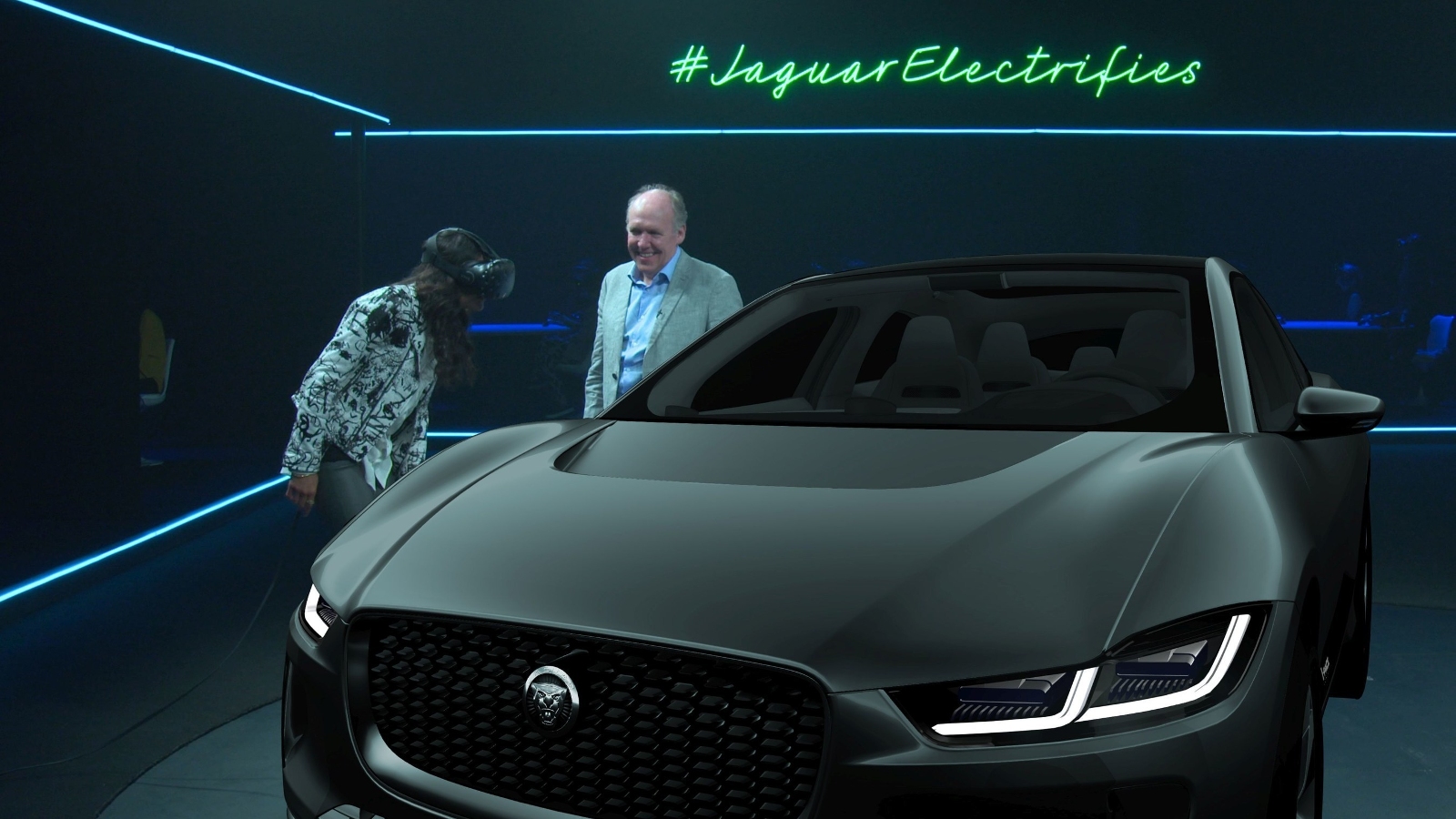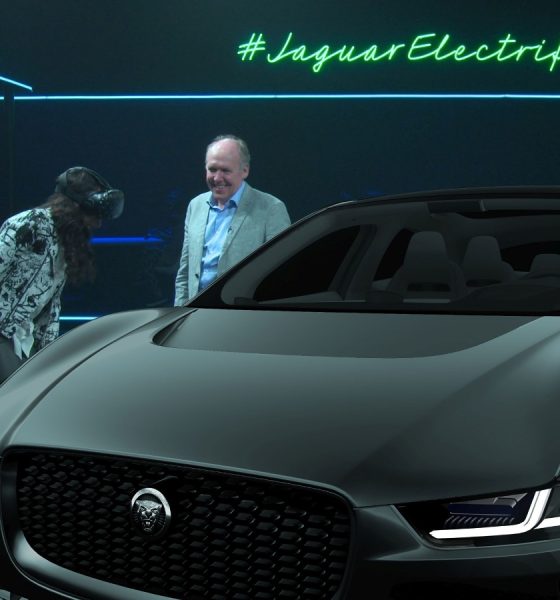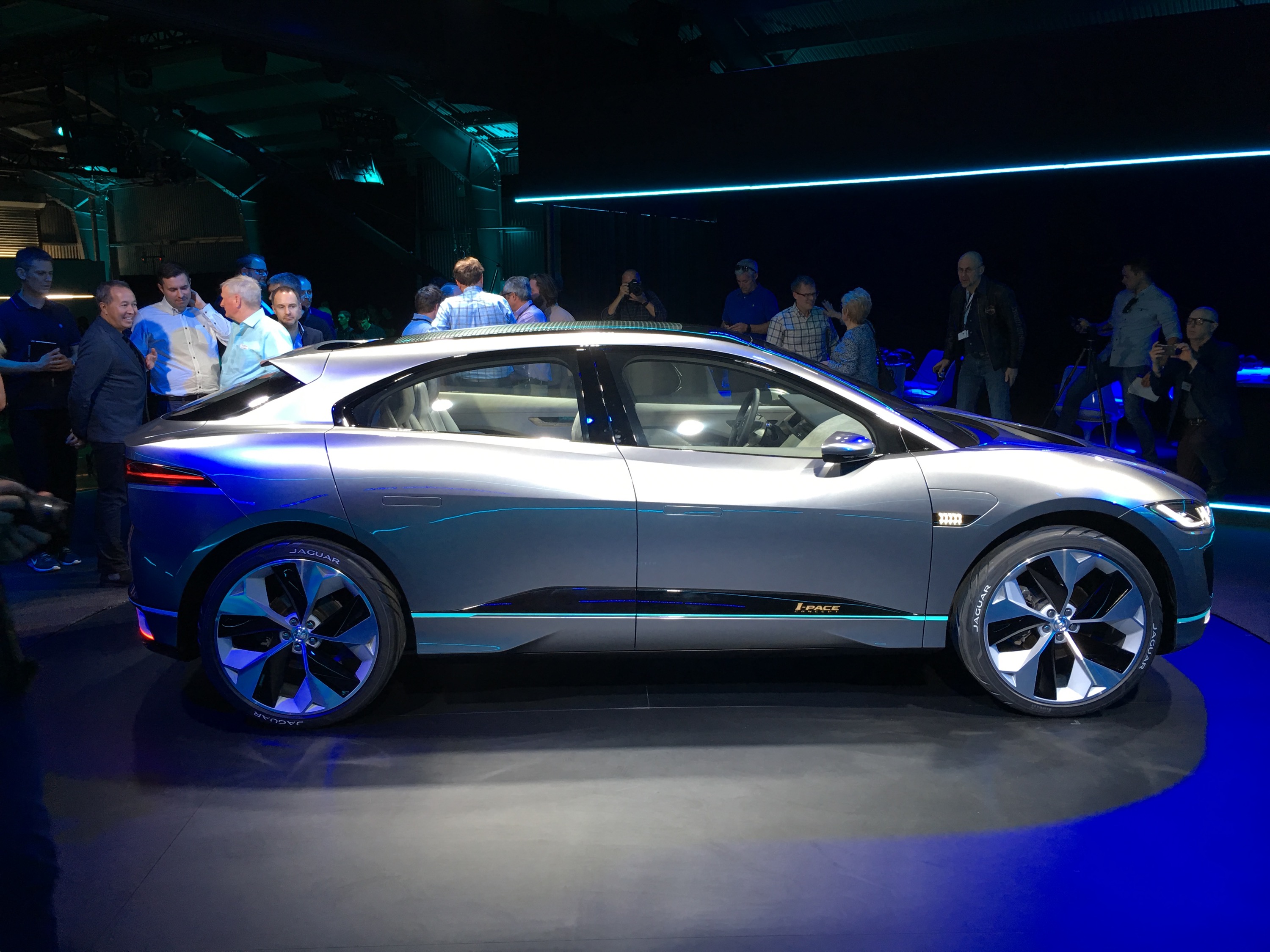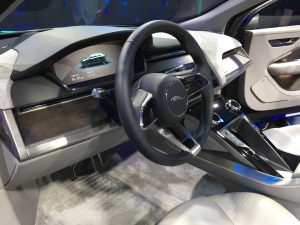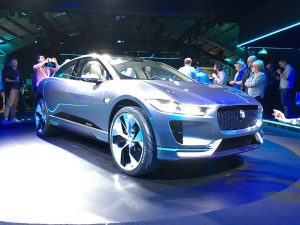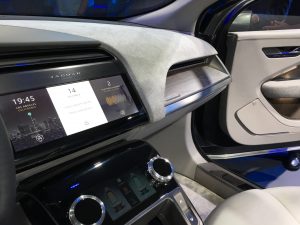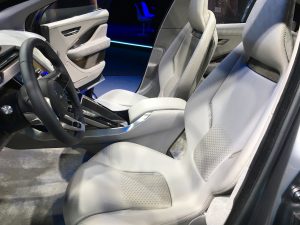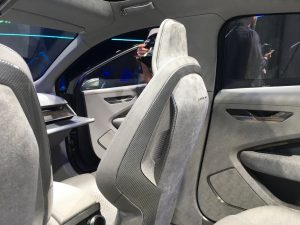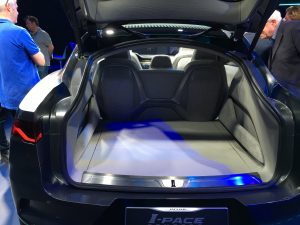The audience put on their HTC Vive headsets, which allowed everyone to see each other at their tables with color-coded avatars. A virtual mini slot car track appeared, and each person grabbed a single Vive controller and competed with others at their tables. Little Jaguar slot cars flew around and off the virtual track. Conversations erupted and interactions flourished as the audience played and waited. Soon, a presenter via live local video feed arrived, and the virtually-enhanced room suddenly filled with the avatars of all 66 people present, interconnecting everyone through virtual reality (VR).
The video feed switched everyone’s attention. It outlined Jaguar’s journey from its founding as the Swallow Sidecar Company in 1922, to this moment in time prior to the 2016 LA Auto Show, with the flashy reveal of a concept version of its I-Pace all electric sport utility vehicle.
The Jaguar I-Pace Concept is essentially a direct competitor to Tesla’s Model X P90D, with a dual motor design and 90 kWh battery that puts out an equivalent of about 400 horsepower and 700 ft. lbs. of torque. The Jaguar model is 12″ shorter, 3″ narrower, and a tiny bit taller than the Tesla product. It will feature a 90 kWh battery that should give the car approximately 300 miles of range using the U.S. testing standard. The battery should be able to recharge to 80% in just an hour and a half. The Jaguar electric powered SUV is purported to be capable of going from 0 to 60 mph in roughly four seconds. Jaguar is hoping to bring the vehicle into production sometime in 2018.
Yes, the Jaguar I-Pace is supposed to compete against the Tesla Model X. But the Jaguar VR press statement experience, using presenters, 3D models, diagrams, animations, and designs — generated through a Jaguar partnership with the Imagination Agency and help from REWIND, HTC, and Dell — far exceeded any hard-to-hear Tesla press conference or Elon Musk live appearance with poorly supported PowerPoint in the background.
- The Jaguar I-PACE.
Photo credit: caradvice.com.au
Early into Jaguar’s virtual reality press statement, Ian Callum, Jaguar’s famous designer, was introduced. He shared a think-aloud about the I-Pace design. True to Callum’s mantra that “It’s about beauty of line and purity of form,” he displayed interactive sketches, wire meshes, battery packs, motors, and other parts of the I-Pace vehicle that will work together in a gestalt. Each member of the audience fully interacted with the same 3D models as he discussed them. Because all headsets were interconnected, two groups of people participating from the UK were able to join in through virtual connecting. While users peered inside a finished Jaguar I-Pace prototype, an actual, real-world version of the vehicle was rolled into the room.
According to audience members present, the overall design, implementation, and explanation of the Jaguar I-Pace was nearly perfectly executed in VR and offered a never-before-experienced sense of product engagement and immersion. Many people left the Jaguar VR press statement convinced of the vehicle’s attributes, design, and performance as well as its capacity to compete fully against Tesla.
And they never learned the price of the Jaguar I-Pace.
[Shout out to Anshel Sag for sharing his VR experience]

Elon Musk
Elon Musk’s X will start using a Tesla-like software update strategy
The initiative seems designed to accelerate updates to the social media platform, while maintaining maximum transparency.

Elon Musk’s social media platform X will adopt a Tesla-esque approach to software updates for its algorithm.
The initiative seems designed to accelerate updates to the social media platform, while maintaining maximum transparency.
X’s updates to its updates
As per Musk in a post on X, the social media company will be making a new algorithm to determine what organic and advertising posts are recommended to users. These updates would then be repeated every four weeks.
“We will make the new 𝕏 algorithm, including all code used to determine what organic and advertising posts are recommended to users, open source in 7 days. This will be repeated every 4 weeks, with comprehensive developer notes, to help you understand what changed,” Musk wrote in his post.
The initiative somewhat mirrors Tesla’s over-the-air update model, where vehicle software is regularly refined and pushed to users with detailed release notes. This should allow users to better understand the details of X’s every update and foster a healthy feedback loop for the social media platform.
xAI and X
X, formerly Twitter, has been acquired by Elon Musk’s artificial intelligence startup, xAI last year. Since then, xAI has seen a rapid rise in valuation. Following the company’s the company’s upsized $20 billion Series E funding round, estimates now suggest that xAI is worth tens about $230 to $235 billion. That’s several times larger than Tesla when Elon Musk received his controversial 2018 CEO Performance Award.
As per xAI, the Series E funding round attracted a diverse group of investors, including Valor Equity Partners, Stepstone Group, Fidelity Management & Research Company, Qatar Investment Authority, MGX, and Baron Capital Group, among others. Strategic partners NVIDIA and Cisco Investments also continued support for building the world’s largest GPU clusters.
News
Tesla FSD Supervised wins MotorTrend’s Best Driver Assistance Award
The decision marks a notable reversal for the publication from prior years, with judges citing major real-world improvements that pushed Tesla’s latest FSD software ahead of every competing ADAS system.

Tesla’s Full Self-Driving (Supervised) system has been named the best driver-assistance technology on the market, earning top honors at the 2026 MotorTrend Best Tech Awards.
The decision marks a notable reversal for the publication from prior years, with judges citing major real-world improvements that pushed Tesla’s latest FSD software ahead of every competing ADAS system. And it wasn’t even close.
MotorTrend reverses course
MotorTrend awarded Tesla FSD (Supervised) its 2026 Best Tech Driver Assistance title after extensive testing of the latest v14 software. The publication acknowledged that it had previously criticized earlier versions of FSD for erratic behavior and near-miss incidents, ultimately favoring rivals such as GM’s Super Cruise in earlier evaluations.
According to MotorTrend, the newest iteration of FSD resolved many of those shortcomings. Testers said v14 showed far smoother behavior in complex urban scenarios, including unprotected left turns, traffic circles, emergency vehicles, and dense city streets. While the system still requires constant driver supervision, judges concluded that no other advanced driver-assistance system currently matches its breadth of capability.
Unlike rival systems that rely on combinations of cameras, radar, lidar, and mapped highways, Tesla’s FSD operates using a camera-only approach and is capable of driving on city streets, rural roads, and freeways. MotorTrend stated that pure utility, the ability to handle nearly all road types, ultimately separated FSD from competitors like Ford BlueCruise, GM Super Cruise, and BMW’s Highway Assistant.
High cost and high capability
MotorTrend also addressed FSD’s pricing, which remains significantly higher than rival systems. Tesla currently charges $8,000 for a one-time purchase or $99 per month for a subscription, compared with far lower upfront and subscription costs from other automakers. The publication noted that the premium is justified given FSD’s unmatched scope and continuous software evolution.
Safety remained a central focus of the evaluation. While testers reported collision-free operation over thousands of miles, they noted ongoing concerns around FSD’s configurable driving modes, including options that allow aggressive driving and speeds beyond posted limits. MotorTrend emphasized that, like all Level 2 systems, FSD still depends on a fully attentive human driver at all times.
Despite those caveats, the publication concluded that Tesla’s rapid software progress fundamentally reshaped the competitive landscape. For drivers seeking the most capable hands-on driver-assistance system available today, MotorTrend concluded Tesla FSD (Supervised) now stands alone at the top.
News
Elon Musk’s Grokipedia surges to 5.6M articles, almost 79% of English Wikipedia
The explosive growth marks a major milestone for the AI-powered online encyclopedia, which was launched by Elon Musk’s xAI just months ago.

Elon Musk’s Grokipedia has grown to an impressive 5,615,201 articles as of today, closing in on 79% of the English Wikipedia’s current total of 7,119,376 articles.
The explosive growth marks a major milestone for the AI-powered online encyclopedia, which was launched by Elon Musk’s xAI just months ago. Needless to say, it would only be a matter of time before Grokipedia exceeds English Wikipedia in sheer volume.
Grokipedia’s rapid growth
xAI’s vision for Grokipedia emphasizes neutrality, while Grok’s reasoning capabilities allow for fast drafting and fact-checking. When Elon Musk announced the initiative in late September 2025, he noted that Grokipedia would be an improvement to Wikipedia because it would be designed to avoid bias.
At the time, Musk noted that Grokipedia “is a necessary step towards the xAI goal of understanding the Universe.”
Grokipedia was launched in late October, and while xAI was careful to list it only as Version 0.1 at the time, the online encyclopedia immediately earned praise. Wikipedia co-founder Larry Sanger highlighted the project’s innovative approach, noting how it leverages AI to fill knowledge gaps and enable rapid updates. Netizens also observed how Grokipedia tends to present articles in a more objective manner compared to Wikipedia, which is edited by humans.
Elon Musk’s ambitious plans
With 5,615,201 total articles, Grokipedia has now grown to almost 79% of English Wikipedia’s article base. This is incredibly quick, though Grokipedia remains text-only for now. xAI, for its part, has now updated the online encyclopedia’s iteration to v0.2.
Elon Musk has shared bold ideas for Grokipedia, including sending a record of the entire knowledge base to space as part of xAI’s mission to preserve and expand human understanding. At some point, Musk stated that Grokipedia will be renamed to Encyclopedia Galactica, and it will be sent to the cosmos.
“When Grokipedia is good enough (long way to go), we will change the name to Encyclopedia Galactica. It will be an open source distillation of all knowledge, including audio, images and video. Join xAI to help build the sci-fi version of the Library of Alexandria!” Musk wrote, adding in a later post that “Copies will be etched in stone and sent to the Moon, Mars and beyond. This time, it will not be lost.”
